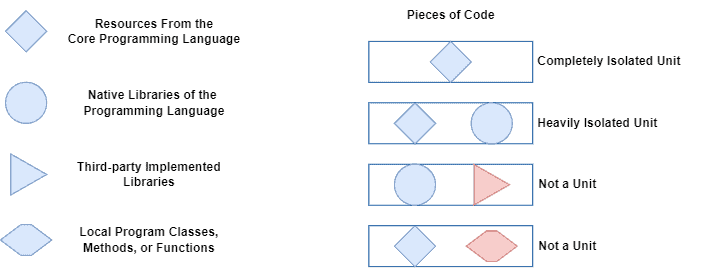1. 引言
尝一口苹果和尝一口苹果派是不一样的体验。 虽然苹果是苹果派的主要原料,但整个派还融合了其他元素(如面皮、奶油等),从而形成了更复杂的风味。因此,品尝苹果是在评估原材料,而品尝苹果派则是在分析苹果经过加工后的整体表现。
我们可以用这个直观的例子来理解编程中的“单元测试”和“集成测试”:前者关注代码中的基本组件,后者则关注这些组件组合后的行为。
在本文中,我们将深入探讨单元测试和集成测试的概念、特点以及它们之间的区别。我们不会过多讲解测试的基础知识,而是假设你已有一定经验,直接进入重点内容。
2. 测试是什么?
测试是用于验证软件是否满足预定义需求并确保其无缺陷的一系列方法和流程。其核心目的是发现软件实现与需求规范之间的潜在错误或不一致。
测试带来的高层次好处包括:
- ✅ 成本效益高:提前发现潜在问题,降低后期修复成本
- ✅ 提升产品质量:确保功能与非功能需求都得到满足
- ✅ 提高客户满意度:如UI/UX测试可以提升用户体验
测试通常分为三类:功能测试、非功能测试和维护测试。其中,单元测试和集成测试属于功能测试的范畴。
3. 单元测试(Unit Testing)
单元测试负责验证代码中最小可测试单元的正确性。 这些单元通常是独立的函数、方法或类,它们在隔离环境下运行,不依赖其他模块或外部资源。
关键点:
- ✅ 独立性:单元测试应与外部依赖隔离,如数据库、网络、第三方库等
- ✅ 快速执行:由于测试范围小,执行速度快,反馈快
- ✅ 开发人员主导:通常由编写代码的开发人员编写和执行
- ✅ 白盒测试:测试者了解内部实现逻辑
例如,以下是一个简单的 Java 单元测试方法:
public class CalculatorTest {
@Test
public void testAdd() {
Calculator calc = new Calculator();
assertEquals(5, calc.add(2, 3));
}
}
单元测试的结构示意如下:

优点:
- ❗错误定位容易
- ✅ 维护成本低
- ✅ 可以在开发早期阶段频繁运行
4. 集成测试(Integration Testing)
集成测试关注的是多个单元之间的协作和交互。 它测试的是模块之间接口的正确性,以及它们如何协同工作完成更复杂的任务。
关键点:
- ✅ 非隔离环境:多个单元组合运行,可能涉及数据库、网络、外部服务等
- ✅ 验证整体行为:确保模块组合后仍能正常工作
- ✅ 测试团队主导:通常由独立的测试团队执行
- ✅ 黑盒测试为主:测试者不关心内部实现细节,只关注输入输出
例如,以下是一个涉及多个类协作的集成测试示例:
public class OrderServiceIntegrationTest {
@Test
public void testPlaceOrder() {
OrderService orderService = new OrderService(new PaymentGateway(), new InventorySystem());
boolean result = orderService.placeOrder("product123", 2);
assertTrue(result);
}
}
集成测试的结构示意如下:

优点与挑战:
- ❗错误定位较难
- ⏱️ 执行速度慢
- ✅ 能发现单元测试无法覆盖的接口问题
- ❗维护成本较高
5. 单元测试 vs 集成测试:对比总结
| 特性 | 单元测试 | 集成测试 |
|---|---|---|
| 测试对象 | 独立的小段代码 | 多个单元组合 |
| 执行者 | 开发人员 | 测试团队 |
| 错误定位 | 容易 | 困难 |
| 测试类型 | 白盒测试 | 黑盒测试 |
| 维护难度 | 简单 | 复杂 |
| 成本 | 极低 | 较高 |
6. 总结
单元测试和集成测试是功能测试中两个不可或缺的组成部分。 单元测试用于验证代码的基本单元是否正常工作,而集成测试则用于验证这些单元在组合后的协作是否符合预期。
在实际项目中,两者应相辅相成:
- ✅ 单元测试用于快速发现问题,提升开发效率
- ✅ 集成测试用于确保系统整体功能的正确性
踩坑提醒: 不要只写单元测试而不写集成测试,也不要反过来。两者结合使用,才能构建出更健壮、可维护的系统。
最终,我们建议在 CI/CD 中同时运行单元测试和集成测试,以保证代码质量和系统稳定性。